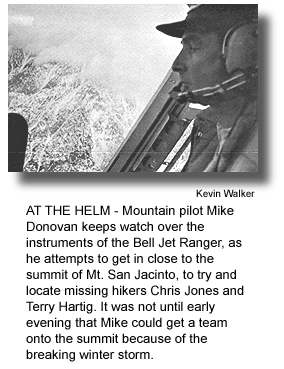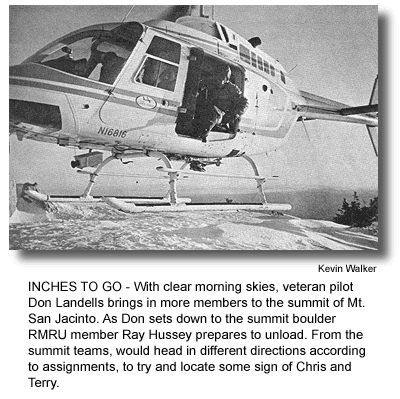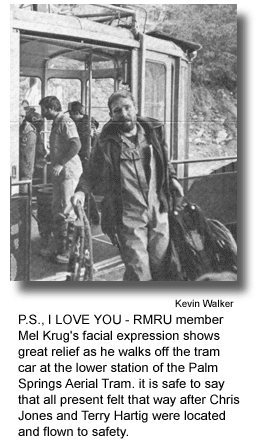Four climbers on North Face in bad weather
|
February 4, 1985 |
 |
By Rob Gardner
At about 6:00 a.m. on February 2, 1985 four strong hikers began pursuit up the steep North Face escarpment of Mt.
San Jacinto. It had been snowing in nearby Banning since 4:00 a.m. The heavy storms continuing, it was snowing in Palm Springs by 7:30 a.m.
Christopher Jones (age 31, from San Diego), Terry Hartig (age 26, from Balboa Island), John Collett, and Doug Kosti continued their hike up Snow Creek Canyon in spite of the adverse weather conditions. Their goal was the peak of Mt. San Jacinto. The hikers had been unable to get a permit because the route has been closed since November 1984. Nonetheless, the climbers got past the water company at the bottom of the canyon and continued up toward the Isthmus area.
At about 8:30 a.m. the Palm Springs Aerial Tramway began to close the road to the lower Tramway station, eventually closing the road to all traffic due to the unsafe icy road conditions. This road leads from Palm Springs (at about sea level) to the lower Tram station at 2,500 feet above sea level. Snow in Banning is uncommon and snow in Palm Springs is a rarity. It snowed all day Saturday and through the night.
 Chris, Terry, John and Doug
proceeded up the North Face, past the Isthmus and
on towards the snow tongue area. They bivouacked
Saturday night and resumed the climb on Sunday
morning. At about 5,000 feet altitude Chris
suddenly lost his footing, taking a fall on the
loose snow. In the fall Chris' ice-axe
accidentally struck John Collett on the head.
John was not seriously injured, however, it was
eventually decided that John would turn back.
Doug Kosti accompanied John on the hike back to
Snow Creek Village. Chris and Terry continued
forward, climbing up the main chute over Snow
Creek on the steep northern face of Mt. San
Jacinto.
Chris, Terry, John and Doug
proceeded up the North Face, past the Isthmus and
on towards the snow tongue area. They bivouacked
Saturday night and resumed the climb on Sunday
morning. At about 5,000 feet altitude Chris
suddenly lost his footing, taking a fall on the
loose snow. In the fall Chris' ice-axe
accidentally struck John Collett on the head.
John was not seriously injured, however, it was
eventually decided that John would turn back.
Doug Kosti accompanied John on the hike back to
Snow Creek Village. Chris and Terry continued
forward, climbing up the main chute over Snow
Creek on the steep northern face of Mt. San
Jacinto.
Late Sunday the storm subsided and the clouds thinned. Chris and Terry planned to achieve the 10,804' peak of Mt. San Jacinto on Sunday afternoon and to then hike over to the upper Tramway station in Long Valley (8,500'). They were to then ride the Tramway down to Palm Springs, where an automobile had been left for them in the lower Tramway station parking lot.
Sunday afternoon was of gentle weather, but still very cold. Even in Palm Springs temperatures were dropping to freezing in the night. Long Valley was dropping near zero degrees Fahrenheit, before adding on the chill factor.
Chris and Terry did not make their destination on Sunday. On Monday Chris Jones' wife, Jerri Jones, contacted the California State Park Ranger at Long Valley and reported that Chris and Terry were overdue hikers. Jerri gave the Ranger information on the planned route, the gear and clothing the men had with them, and information of their experience. Both men reportedly had climbed the North Face before and were high caliber mountaineers. They had good clothing and adequate gear with them.
RMRU was called out by the Riverside County Sheriff's Office (RSO) at 2:10 p.m. on Monday, February 4,1985. It was very surprising and concerning to hear that the call-out was to the North Face of Mt. San Jacinto. With the heavy fall of new snow in that area the immediate concern was of avalanches in the chutes, with particular concern for the higher altitudes of the main chute. It is generally agreed that the prudent do not enter this route after new snow until enough days and proper weather conditions have occurred to allow the snow to consolidate.
The RMRU team members met at Snow Creek Village. With only a couple of hours of day light left and clouds around the top 2,000' of the mountain a helicopter was requested. The RSO cleared for a helicopter to be dispatched from Landells Aviation Service. Pilot Mike Donovan arrived at Snow Creek Village, where RMRU team members, Jim Fairchild and Kevin Walker, boarded the chopper and proceeded on to make an immediate visual assessment. The other RMRU members prepared for a cold night of searching in the mountains.
About twenty minutes later Kevin made a radio contact with base and reported that two sets of clear foot prints had been located in the snow at the bottom of the snow tongue. The footprints were in the main chute, at about 5,100' altitude.
It was only a few more minutes before Kevin was on the radio again and advised that the helicopter was at 5,700' altitude, where the clear footprints vanished under the tail end of a massive avalanche. Mike flew the helicopter up the chute to 9,000 feet altitude and the origin of this major avalanche could not yet be seen. The avalanche covered the chute, obliterating all that was in it's path. The avalanche had started above the 9,000 foot level. Mike could not check any higher due to the cloud cover. The avalanche was major, the snow having fallen down the sides of the chute as well as from the top. The avalanche covered over 4,000 vertical feet.
The chute was too unstable to place anybody in it on Monday. Two teams were flown up and around the clouds and then over Mt. San Jacinto peak at 10,804' and left on the peak. Darkness was setting in and the helicopter headed home in the dark after leaving the second team on the peak.
The search went on through the night to cover areas between the peak and the upper Tramway station. This area was searched on the premise that Chris and Terry were not under the avalanche, but may have made it out of the chute, the avalanche wiping out their footprints. One team on the peak was to check the summit area for any signs that Chris and Terry had been there, and if no signs were found, that team would hike to the rock house near the peak to see if the overdue hikers might be there. If not, the team was to await daylight, at which time they could re-evaluate snow conditions, etc. and give assessments from the peak to Long Valley, seeking out any tracks or other signs that the overdue hikers may have been in that area.
Randy Iwasiuk and Curtis Pontynen were assigned to the summit. Joel Ericson later joined that team. Bernie McIlvoy was assigned to check the route down to Long Valley. The cloud cover had dissipated, allowing Bernie to ski the route by moonlight, traversing and covering miles and miles of the terrain. Bernie only found the tracks that Jon Wallace of the Nordic Ski Center had left, when he searched the area earlier in the day. Other than Jon's tracks, no signs of people were found by Bernie. Bernie did see the results of another avalanche on the eastern slope to the summit.
The rest of the RMRU team moved from Snow Creek Village to the Tramway Mountain station to reestablish a base camp. Cameron Robbins and Colin Chambers were dispatched on snow shoes to cover the area from Long Valley to Tamarack Valley, by the route through Shangri La. They then hiked over to Round Valley and returned to Long Valley on the standard route. They returned to base at about 2:30 p.m. reporting no signs found of Chris and Terry. A few months earlier two Marines two days overdue from the North Face had made their way to Shangri La after getting off route.
John Dew managed the radios and logs at base camp and Bill Blaschko checked out the Long Valley vicinity.
The night went on without any clues to the whereabouts of Chris and Terry, except for the footprints ending at the bottom of the avalanche.
Kevin Walker was the Operations Leader for this mission. Kevin worked into the morning hours planning new strategy for daylight on Tuesday. State Park Ranger Rick Brown remained on duty through the night making numerous telephone contacts and interviews, gathering detailed information regarding the overdue men's ability, equipment, clothing, experience, attitudes, personality, etc. National Weather Service Meteorologist Carl Garczynski was contacted for a forecast for Tuesday. The forecast was for clear skies, a definite positive as RMRU wanted to have the helicopter in the air at daybreak on Tuesday, if at all possible.
The RMRU men that were not already in the field got a good meal and grabbed about three hours of sleep to be prepared for dispatch into the field at first light. Thanks go to Mr. Sherman Harris and the Palm Springs Aerial Tramway for their support and cooperation.
 It was difficult to get much sleep
during those three hours as the haunt of the main
chute avalanche remained in probably
everybody’s mind.
It was difficult to get much sleep
during those three hours as the haunt of the main
chute avalanche remained in probably
everybody’s mind.
At daybreak the next search phase was put into motion. Three more teams were placed on the peak to search towards Little Round Valley, jean Peak, and Cornell Peak. Once those teams were in position the helicopter was to pick up a team member as a spotter and drop over the North Face to continue an air search in that vicinity. As the helicopter was about to depart for the spotter, it was called back to transport Joel Ericson down from the peak. Joel had been flown in to the peak on Monday at sundown. He had made a quick gain of about 10,000 feet altitude and was now suffering serious altitude sickness. once Joel was off the mountain and getting medical attention the spotter was picked up and the air search resumed.
At the peak, Rob Gardner located about ten deteriorated foot prints in the icy snow. The prints included signs of crampons. This was the first new lead as the teams departed on their assigned routes. It was not more than fifteen minutes before Cameron Robbins broadcasted over the radio that he could see clear and continuing tracks in the snow on the Western side of the mountain. The helicopter was brought up from the North Face and very quickly followed the tracks until two men were sighted. The helicopter, piloted by Don Landells, found a clearing in the trees and descended to a hover on the snow covered slope. The RMRU spotter, Walt Walker, jumped out of the bird and sank into the powdery snow clear up to his mid thighs. Don lifted off and flew away so that Walt could shout to the two men. It was quickly established that they were Christopher Jones and Terry Hartig, the overdue hikers. The men were in good condition but very far off route, which they did not know until told so by Walt.
 Chris and Terry reported that they
had left the main chute of Sunday, taking a chute
to the West. They reported that about ten minutes
after changing route the major avalanche occurred
in the main chute. Chris said the avalanche
"sounded like a freight train going
by." They had continued hiking up the side
chute and inadvertently went to Folly Peak. Upon
getting to Folly Peak, they recognized this error
and climbed over to Mt. San Jacinto Peak,
arriving there at 10:00 P.M. on Monday night.
Being only five minutes from the rock house,
where three RMRU men awaited, Chris and Terry
were apparently disoriented and hiked the
opposite way by 180 degrees. When located they
said they were hiking to the Tramway Station. In
fact, they were hiking farther away from the
station. Although they were off route, they had
not suffered injury and were still strong.
However, they were not too resistant to a
helicopter ride back to the Snow Creek Village.
John, Doug, and Jerri were happy to see that
Chris and Terry were okay, as were RMRU, State
Park, RSO and Tramway personnel.
Chris and Terry reported that they
had left the main chute of Sunday, taking a chute
to the West. They reported that about ten minutes
after changing route the major avalanche occurred
in the main chute. Chris said the avalanche
"sounded like a freight train going
by." They had continued hiking up the side
chute and inadvertently went to Folly Peak. Upon
getting to Folly Peak, they recognized this error
and climbed over to Mt. San Jacinto Peak,
arriving there at 10:00 P.M. on Monday night.
Being only five minutes from the rock house,
where three RMRU men awaited, Chris and Terry
were apparently disoriented and hiked the
opposite way by 180 degrees. When located they
said they were hiking to the Tramway Station. In
fact, they were hiking farther away from the
station. Although they were off route, they had
not suffered injury and were still strong.
However, they were not too resistant to a
helicopter ride back to the Snow Creek Village.
John, Doug, and Jerri were happy to see that
Chris and Terry were okay, as were RMRU, State
Park, RSO and Tramway personnel.
Chris Jones and Terry Hartig were probably spared by a combination of skill, proper gear, and a very lot of good luck, The moral to this story is, stay off of Mt. San Jacinto's North Face when there is fresh snow!
Publisher's Note: RMRU learned recently that one of the mountaineers in the previous mission did indeed suffer some fairly serious frostbite to the toes. We were happy to hear also that he is not going to lose any of the toes.